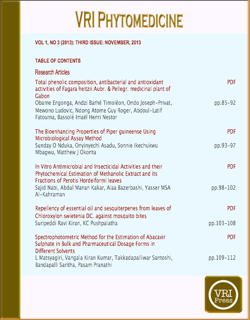
Repellency of essential oil and sesquiterpenes from leaves of Chloroxylon swietenia DC. against mosquito bites
Abstract
Chloroxylon swietenia DC. is a medicinal as well as aromatic tree of tropical dry deciduous forests native to Indian and Srilanka. Analysis of essential oil from leaves isolated by hydrodistillation was carried out by GC and GC-MS. The essential oil was found to be rich in limonene, trans-β-ocimene, pregeijerene, geijerene and germacrene D. Based on an arm-in-cage test, the oil and the isolated sesquiterpenes namely, germacrene D, pregeijerene and geijerene were screened for repellent activity against Aedes aegypti and Anopheles gambiae and compared favourably with a positive control sample, DEET. The crude oil exhibited potent repellency with RD50 of 22.2 & 25.1x10-5 mg/cm-2 respectively for two mosquito species followed by germacrene D, pregeijerene and geijerene. However, the crude oil was found to be equally potent as DEET, a widely used insect repellent which showed RD50 of 20.6 & 22.4x10-5 mg/cm-2. The results indicate the potential of oil and sesquiterpene compounds for future field trials in various mosquito eradication programmes.
Keywords
Full Text:
PDFReferences
WHO: Report of the WHO informal consultation on the evaluation and testing of insecticides. Geneva: World Health Organization, 1996a, 9.
Taubes GA: A mosquito bites back. New York Times Magzine. 1997, 24:40-46.
NIMR: A national lymphatic filariasis elimination programme (NLFEP). National Institute for Medical Research, Ministry of Health, Dar es Salaam, Tanzania. 2001.
Fradin MS: Mosquitoes and mosquito repellents: a clinician's guide. Annals of Internal Medicine 1998, 128:931-940.
http://dx.doi.org/10.7326/0003-4819-128-11-199806010-00013
PMid:9634433
Goodyer L, Behrens RH: The safety and toxicity of insect repellents. American Journal of Tropical Medicine and Hygiene 1998, 59:323-324.
PMid:9715955
Edwards DL, Johnson CE: Insect-repellent-induced toxic encephalopathy in a child. Clinical Pharmacology 1987, 6:496-498.
Qui H, Jun HW, McCall JW: Pharmacokinetics, formulation and safety of insect repellent N,N-diethyl-3-methylbenzamide (DEET): A review. Journal of American Mosquito Control Association 1998, 14:12-27.
Tawatsin A, Wratten SD, Scott RR, Thavara U, Techadamrongsin Y: Repellency of volatile oils from plants against three mosquito vectors. Journal of Vector Ecology 2001, 26:76-82.
PMid:11469188
Pitasawat B, Choochote W, Tuetun B, Tippawangkosol, Kanjanapothi D, Jitpakdi A, Riyong D: Repellency of aromatic turmeric Curcuma aromatica under laboratory and field conditions. Journal of Vector Ecology 2003, 28:234-240.
PMid:14714673
Omolo MO, Okinyo D, Ndiege IO, Lwande W, Hassanali A: Repellency of essential oils of some Kenyan plants against Anopheles gambiae. Phytochemistry 2004, 65:2797-2802.
http://dx.doi.org/10.1016/j.phytochem.2004.08.035
PMid:15474566
Omolo MO, Okinyo D, Ndiege IO, Lwande W, Hassanali A: Fumigant toxicity of essential oils of some African plants and constituents of Conyza newii (Compositae) against Anopheles gambiae sensu stricto. Phytomedicine Research 2005, 12: 241-246.
http://dx.doi.org/10.1016/j.phymed.2003.10.004
PMid:15830848
Kirtikar KR, Basu BD: Indian Medicinal Plants, Vol. I & II, periodical experts, Delhi, 1935 : 546-565.
Jennings W, Shibamoto T: Qualitative analysis of Flavour and Fragrance volatiles by glass capillary chromatography. Academic Press, New York. 1980.
Adams RP: Identification of essential oils by Ion Trap Mass Spectrometry. Academic press, New York; 1989.
Davies NW: Gas chromatographic retention indices of monoterpenes and sesquiterpenes on methyl silicon and Carbowax 20M phases. Journal of Chromatography 1990, 503:1-24.
http://dx.doi.org/10.1016/S0021-9673(01)81487-4
Schreck CE, McGovern TP: Repellents and other personal protection strategies against Aedes albopictus. Journal of American Mosquito Control Association 1989, 5:247-252.
PMid:2746209
WHO: Report of the WHO Informal Consultation on the Evaluation and Testing of Insecticides. CTD/WHOPES/IC/96.1. Control of Tropical Diseases Division, World Health Organization: Geneva. 1996b.
Mehr ZR, Rutledge LC, Morales EL, Meixsall VE, Korte DW: Laboratory evaluation of controlled release insect repellent formulations. Journal of American Mosquito Control Association 1985, 1:143-147.
PMid:3880224
Finney DJ: Probit Analysis, third ed. Cambridge University Press, Cambridge. 1971: 9-18.
Busvine JB: A Critical Review of the Techniques for Testing Insecticides, second ed. Commonwealth Agricultural Bureaux, England; 1971:263-277.
Srivastava M, Saxena A, Baby P: GC-MS analysis and antimicrobial activity of essential oil of Chloroxylon swietenia. SOFW Journal. 1988, 124:558-559.
Garg SC, Oswal VB: Essential oil from the leaves of Chloroxylon swietenia. Indian Perfumer 1996, 40:76-78.
Umer Sharief Md, Jagadishchandra KS: Biotechnological approaches of aromatic trees relevance to Chloroxylon swietenia DC.: Micropropagation and its phytochemical studies. In: Role of Biotechnology in Medicinal and Aromatic Plants (ed. Irfan A. Khan and Atiya Khanum). 1999, 2:376 – 391.
Cockcroft A, Cosgrove JB, Woods RJ: Comparative repellency of commercial formulations of DEET, permethrin and citronellal against the mosquito Aedes aegypti, using a collagen membrane technique compared with human arm tests. Medical and Veterinary Entomology 1998, 12:289-294.
http://dx.doi.org/10.1046/j.1365-2915.1998.00121.x
PMid:9737601
USEPA: Product performance test guideline OPPTS 810.3700 Insect repellents for human skin and outdoor premises. United States Environmental Protection Agency, Washington D.C. Office of Prevention, Pesticides and toxic substances. http://www.epa.gov/opptsfrs/OPPTS_Harmonized/810_Product_Performance_Test_Guideline/Drafts/810-3700.pdf. 2003.
Rutledge LC, Collister DM, Meixsell VE, Eisenberg GHG: Comparative sensitivity of representative mosquitoes (Diptera: Culicidae) to repellents. Journal of Medical Entomology 1983, 20:506-510.
PMid:6139482
Curtis CF, Lines JD, Ijumba J, Callagham A, Hill N, Karimzad MA: The relative efficiency of repellents against mosquito vectors of disease. Medical and Veterinary Entomology 1987, 1:109-119.
http://dx.doi.org/10.1111/j.1365-2915.1987.tb00331.x
PMid:2908762
DOI: http://dx.doi.org/10.14259%2Fpm.v1i3.78
Refbacks
- There are currently no refbacks.






